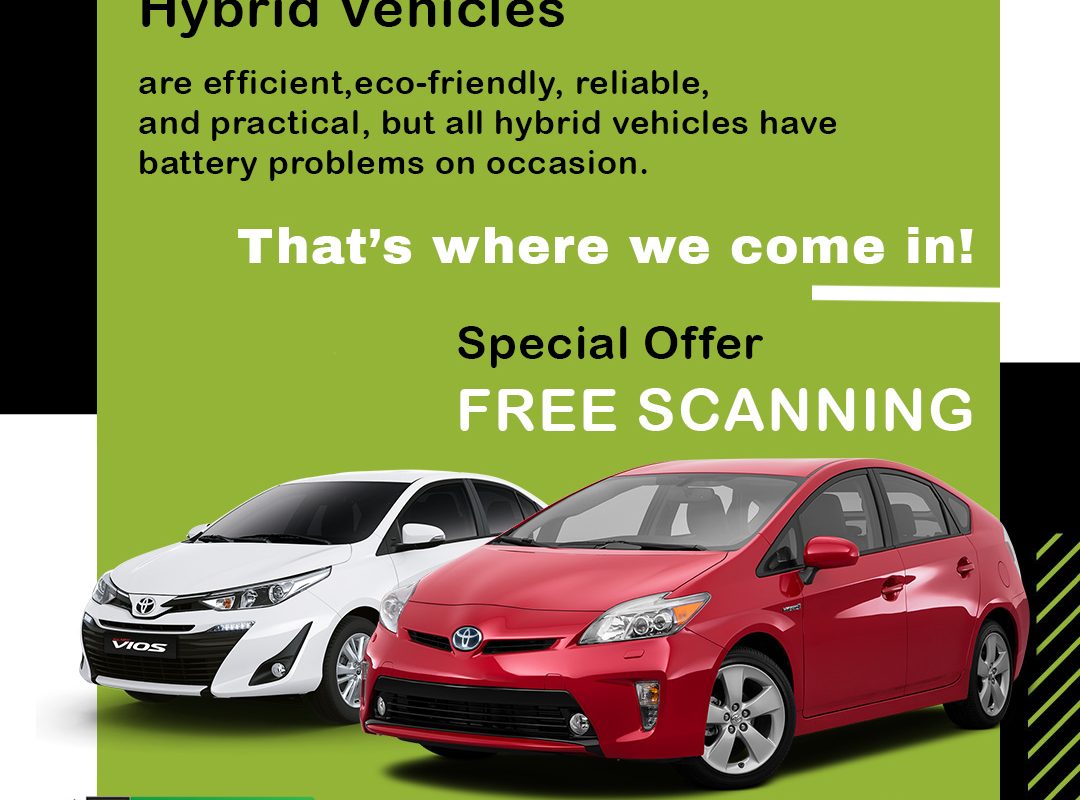Hybrid Vehicles are a great way to conserve our oil supply and have become very popular today. It is great when the Factory warranty is in place and active so when you’re Hybrid Battery fails there is no cost out of pocket. But what about post-warranty failures? What are the options and costs? We will dig into the ever-growing problem with older Hybrid Vehicles.
Introduction
First of all, let’s get to know the type of chemistry that makes up the majority of the Hybrid Batteries today. The most popular one is a Nickel Metal Hydride, which is a great power delivery battery, this means it will charge and discharge quickly. It is a low capacity battery but transfers energy fast. The other Hybrid Batteries are Lithium-Ion batteries, mostly used in Full Electric Vehicles, because of their very good energy density or larger capacity that is needed to give a good range. Kia and Toyota both have a Lithium-Ion Battery as do some of the hybrids. Most of these are still covered under factory warranty so today I am going to focus on the Nickel Metal Hydride Battery that is post-warranty.
Nickel Metal Hydride Batteries
The best part about the Nickel Metal Hydride Battery is that it can be refurbished and shouldn’t be discarded until a Professional like Hybrid Battery Solution can recycle your battery.
Because of shallow cycling (battery never fully charged or discharged) there becomes a dendrite (a crystal or crystalline mass with a branching tree-like structure) buildup on the plates of the cells in the battery. Because they take up area on the plates, capacity is a function of area, therefore capacity is lost. This is a normal occurrence that takes place over a seven-year period. After this amount of time all batteries to be balanced. When this occurs you will notice a decrease in fuel mileage and performance. This is a hard sell when your battery is still functioning, but the truth of the matter is, if this preventive maintenance is done you will save money in the long run and regain your vehicle’s mileage and performance. Remember your battery will now last another seven years before needing a rebalance.
5 Expert Tips to Extend Your Hybrid Battery Life
1. Practice Regular Maintenance
To make your hybrid battery last longer, take good care of it. Keep it clean by checking and cleaning the terminals often. Also, make sure the coolant level is right to prevent overheating. Park in shady spots to keep it cool. These simple steps help your battery stay strong.
2. Improve Your Driving Techniques
Drive smoothly to keep your hybrid battery happy. Avoid sudden stops and starts — they stress the battery. Use regenerative braking to charge it while driving. Also, plan your routes smartly to use the battery well and keep your hybrid running smoothly for longer.
3. Avoid Sudden Speeding and Braking
Drive smoothly, without sudden stops or starts. This not only feels nicer but also helps your hybrid battery last longer. Being gentle with the accelerator and brakes is key.
Sudden moves stress the battery, wearing it out faster. Instead, aim for a steady pace, anticipating traffic changes. Smooth driving means less strain on your battery, making it last longer and work better overall.
As we talk about regenerative braking next, remember that driving smoothly is just the beginning of getting the most out of your hybrid battery.
4. Utilize Regenerative Braking
Use regenerative braking in your hybrid to charge the battery and boost its performance. It turns braking energy into electricity. Here’s how:
1. Predict stops.
2. Brake gently.
3. Keep a safe distance.
4. Try the ‘B’ mode for stronger braking.
These tricks help your battery last longer and work better.
5. Plan Routes in Advance
Plan your routes smartly to get the most out of your battery. This helps manage the charge well and keeps your battery healthy. When planning, think about things like traffic, hills, and how far you’re going.
Pick routes with less traffic and avoid big hills to keep your battery happy. Smooth driving and fewer stops are key. Plus, plan to find charging spots if you need them.
Stress Testing
For this test you will need to find a repair shop that has a scan tool that can gather the live data from you hybrid battery. Special diagnostic tools like the “TechStream” for Toyota or Aftermarket scan tool like Matco or Snap-on will provide the data needed to perform the Stress Test.
Basically what happens during the test is first is to find a safe vacant back street to perform the stress test, once you are ready to start the test, the technician will need clear the Diagnostic Trouble Codes so the car is not in low propulsion mode or limp mode. The data from your hybrid battery is collected and recorded first. Then turn on live data collection and then accelerate the car at full throttle, up to 30 mph and then shifted into neutral prior to braking, so as to not let the regenerative brakes add energy back into the battery, coming to a complete stop. This is repeated five times in a row, stressing the capacity of the battery. Now with the data gathered from the live test, you will now know the true State of Health of your Hybrid Battery. Now you will know when it is time for your Hybrid Battery Reconditioning.
Conclusion
There are not many repair shop that are not trained, including dealerships, nor have ever heard of a Stress Test, even though they probably have the scan too to complete the test. I spend 30% of my time educating people and repair shops on how to properly test the State of Health, so be educated about your Hybrid Vehicles Health and remember, after seven years all Nickel Metal Hydride Batteries are out of balance and need to be rebalanced to perform properly and regain the expected high fuel mileage.
At this time you will need to email me at daniel@hybridbatterysolution.co.nz or Call to 021 148 1200 for a copy of the Stress Test worksheet and I will be happy to help you with any of your hybrid vehicle questions.
I hope this helps you to be more in tune with your Hybrid Vehicles and now know how to properly check your batteries STATE OF HEALTH AND HAPPY YOUR HYBRID BATTERY!





